Muzaffarabad
| Muzaffarabad مُظفّرآباد | |
|---|---|
| City | |
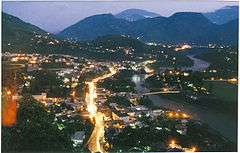 | |
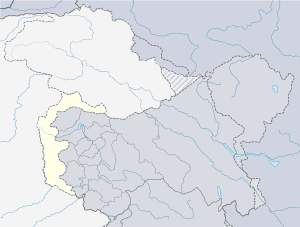 Muzaffarabad  Muzaffarabad | |
| Coordinates: 34°21′40″N 73°27′43″E / 34.361°N 73.462°E | |
| Country |
|
| Territory |
|
| Area | |
| • Total | 6,117 km2 (2,362 sq mi) |
| Elevation | 737 m (2,418 ft) |
| Population (2010) | |
| • Total | 96,000 |
| • Estimate (2010) | 96,000 |
| Time zone | PST (UTC+05:00) |
| Website | Muzaffarabad Local Government |
| Muzaffarabad | ||||||||||||||||||||||||||||||||||||||||||||||||||||||||||||
|---|---|---|---|---|---|---|---|---|---|---|---|---|---|---|---|---|---|---|---|---|---|---|---|---|---|---|---|---|---|---|---|---|---|---|---|---|---|---|---|---|---|---|---|---|---|---|---|---|---|---|---|---|---|---|---|---|---|---|---|---|
| Climate chart (explanation) | ||||||||||||||||||||||||||||||||||||||||||||||||||||||||||||
| ||||||||||||||||||||||||||||||||||||||||||||||||||||||||||||
| ||||||||||||||||||||||||||||||||||||||||||||||||||||||||||||
Muzaffarabad (Urdu: مُظفَّرآباد; Pahari, Potwari: مُظفٌر آباد) is the capital of Azad Jammu and Kashmir, Pakistan.
It is located in Muzaffarabad District on the banks of the Jhelum and Neelum rivers. The district is bounded by Khyber-Pakhtunkhwa in the west, by the Kupwara and Baramulla districts of Indian-administered territory of Jammu and Kashmir in the east, and the Neelum District of Azad Kashmir in the north.
History
Early history
The original name of Muzaffarabad was Udabhanda.[3]
Hieun tsang, the celebrated Buddhist pilgrim who is said to have visited the valley in 633 A.D mentions Pan-nu-tso, i.e., modern day Punch, Ho-lo-she-pu-to i.e. modern day Rajauri. He entered India from Udabhanda, Urasa (present Muzafrabad and Uskara) entered the valley via Baramula gorge.[4]
Udabhanda was the capital of the Shahi dynasty. The Shahi (Devanagari शाही), also called Shahiya,[5][6] dynasties ruled portions of the Kabul Valley (in eastern Afghanistan) and the old province of Gandhara (northern Pakistan and Kashmir) from the decline of the Kushan Empire in third century to the early ninth century.[6] The kingdom was known as Kabul-shahan or Ratbel-shahan from (565 – 670 CE) when they had their capitals in Kapisa and Kabul, and later Udabhandapura (also known as Hund)[7] for its new capital.
The term Shahi is the title of the rulers, likely related to the Kushan form Shao[6] or Persian form Shah and refers to a series of 60 rulers probably descended from the Kushans or Turks (Turshkas).[6]
Modern history
The capital of the Azad Jammu and Kashmir, is situated at the confluence of the Jhelum and Neelum rivers. It is 138 km from Rawalpindi and about 76 km from Abbottabad. The present name of Muzaffarabad has been given to it after the name of Sultan Muzaffar Khan, a chief of Bomba Dynasty (1652). There are two forts, namely, Red and Black Fort, situated on the opposite sides of river Neelum. The Neelum river streams through the town, joins the river Jhelum at Domel and plays a dominant role in the micro-climate of Muzaffarabad.[8]
On October 8, 2005, the city was struck by an earthquake measuring a magnitude of 7.6 on the Richter Scale.[9]
2005 Kashmir earthquake
The city was the site of the epicenter of the 2005 Kashmir earthquake, which occurred on October 8, 2005 and had a magnitude of 7.6. The disaster destroyed 50% of the buildings in the city (including most of the official buildings) and is estimated to have killed up to 80,000 people in the Pakistani-controlled areas of Kashmir.
As of 8 November 2005 the Pakistani government's official death toll was 87,350. Some estimates put the death toll over 100,000.[10]
 Humanitarian aid reaches the devastated far-flung areas of Pakistan's Federally Administered Northern Areas (FANA).
Humanitarian aid reaches the devastated far-flung areas of Pakistan's Federally Administered Northern Areas (FANA).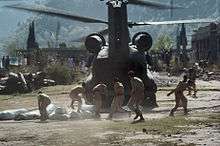 Pakistani Soldiers carry tents away from a U.S. Army CH-47 Chinook helicopter that was there on October 19. The United States took part in the multinational effort to provide humanitarian assistance and support to Pakistan and Afghanistan following the devastating October 8 earthquake.
Pakistani Soldiers carry tents away from a U.S. Army CH-47 Chinook helicopter that was there on October 19. The United States took part in the multinational effort to provide humanitarian assistance and support to Pakistan and Afghanistan following the devastating October 8 earthquake.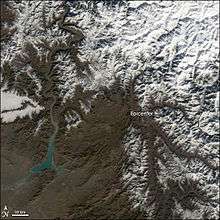 Heavy snowfall in the region around the epicentre, shown here in a January 6, 2006 NASA satellite image, hampered the relief efforts which began shortly after the earthquake struck.
Heavy snowfall in the region around the epicentre, shown here in a January 6, 2006 NASA satellite image, hampered the relief efforts which began shortly after the earthquake struck. Sangam Hotel in Muzaffarabad that was destroyed in the earthquake.
Sangam Hotel in Muzaffarabad that was destroyed in the earthquake.
Valleys
|
|
Gallery
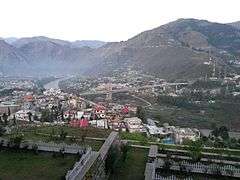 (Jehlum River at Muzaffarabad 2014)
(Jehlum River at Muzaffarabad 2014)- Jhelum River Near Kohala Bridge Kashmir (2014)
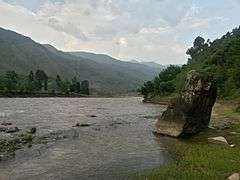 Jehlum River at Muzaffarabad best view(2014)
Jehlum River at Muzaffarabad best view(2014) Lush Green View of Awan Patti
Lush Green View of Awan Patti
Transport
The closest railway stations are Murree in Pakistan and Baramulla in Indian state of Jammu and Kashmir.[11] Jammu and Kashmir ex-chief Minister Ghulam Nabi Azad said that he intended to extend the Kashmir railway to Muzaffarabad, to facilitate movement of people and goods much easier across the LoC Line of Control.[12]
See also
References
- ↑ Muzaffarabad at Sunmap. Sunmap.eu. Retrieved on 2012-07-03.
- ↑ World Weather Information Service. Worldweather.wmo.int (2006-10-05). Retrieved on 2012-07-03.
- ↑ "The original name of Muzaffarabad was Udabhanda.". cleanpakistan.org.
- ↑ Poonam, Chaudhary (2005) A study of cultural routes of Jammu Region. In: 15th ICOMOS General Assembly and International Symposium: ‘Monuments and sites in their setting – conserving cultural heritage in changing townscapes and landscapes’, 17 – 21 oct 2005, Xi'an, China.
- ↑ Sehrai, Fidaullah (1979). Hund: The Forgotten City of Gandhara, p. 1. Peshawar Museum Publications New Series, Peshawar.
- 1 2 3 4 "Shahi Family". Encyclopædia Britannica Online. 16 Oct 2006.
- ↑ Sehrai, Fidaullah (1979). Hund: The Forgotten City of Gandhara, p. 2. Peshawar Museum Publications New Series, Peshawar.
- ↑ "Muzaffarabad". tourism.gov.pk.
- ↑ "Earthquake in Kashmir". storyofpakistan.com.
- ↑ Stuart, Julia. (2006-01-01) IoS Appeal: Last chance to donate to quake victims. News.independent.co.uk. Retrieved on 2012-07-03.
- ↑ Google Maps. Maps.google.co.uk. Retrieved on 2012-07-03.
- ↑ Azad's Vision: A train to Muzaffarabad. News.oneindia.in (2007-07-17). Retrieved on 2012-07-03.
External links
| Wikivoyage has a travel guide for Muzaffarabad. |
| Wikimedia Commons has media related to Muzaffarabad. |
Coordinates: 34°21′N 73°28′E / 34.350°N 73.467°E